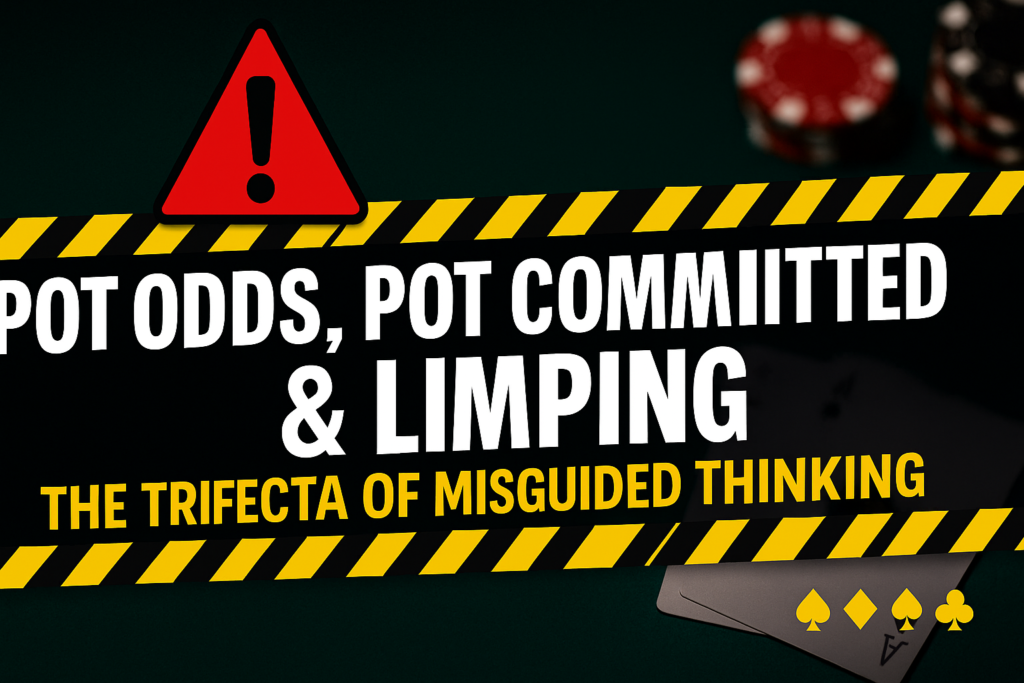THE TRIFECTA OF MISGUIDED THINKING IN POKER
POT ODDS, POT COMMITTED & LIMPING
In poker, few ideas cause more confusion than Pot Odds vs Pot Committed, and the habit of limping. Players toss these concepts around as if they’re simple rules, but in reality, they’re often just misapplied shortcuts that bleed money from a bankroll.
I call these three ideas the Trifecta of Misguided Thinking. Each one has legitimate strategic value, but when used carelessly, they become dangerous leaks. Recreational players lean on them to justify bad calls, questionable folds, and passive play — and the result is predictable: long-term losses.
.

- Pot odds are a critical tool, but when used without factoring in hand equity, they often lead players into calling when they shouldn’t.
- Pot committed isn’t about how much you’ve already invested — it’s about whether folding is mathematically worse than calling.
- Limping is usually a sign of weak play… but not always. While most limps invite exploitation, there are moments where a strategic limp has real purpose — and we’ll explore those exceptions later in this article.
POT ODDS - THE MOST ABUSED MATH IN POKER
When players compare Pot Odds vs Pot Committed, the first mistake usually starts with pot odds. Pot odds are simply the price the pot offers you right now. They only matter when you weigh that price against your hand’s equity and consider who is still left to act.
Here is the correct way to quote the price. Suppose the pot is $150 and your opponent bets $50. The current pot is now $200. Your cost to call is $50. Your pot odds are 200-to-50, which reduces to 4-to-1. The break-even equity equals Cost ÷ (Pot + Cost), so 50 ÷ (200 + 50) = 50 ÷ 250 = 0.20, or 20%. Notice we do not add your call to the pot when stating your price. If you call, the pot becomes $250, and the next player would be offered 250-to-50 = 5-to-1, which needs 1 ÷ (5 + 1) = 16.7%. That is why players behind you matter.
pot odds & hand probabilities
Most misuses come from treating the price as permission. A player in the big blind looks down at 9♦4♠ and says, “I’m getting a price.” They ignore equity, playability, and reverse implied odds. In reality, pot odds without equity are a rationalization.
Now look at a spot where pot odds help. You hold A♠7♠ on K♠-10♠-3♦-5♥. The pot is $300. Villain bets $100. The current pot is $400, your call costs $100, so the price is 4-to-1, which needs 20% equity. A nut-flush draw on the turn has 9 outs with 46 unseen cards. That is 9 ÷ 46 = 0.1956, or 19.6%, which is about 4.1-to-1 against. On pot odds alone, 19.6% is less than 20%, so the call is slightly negative. Two factors can change that. Implied odds can add dollars on the river when you hit. Players behind can call after you, which improves the actual price you realize in real time.
POT ODDS VS POT COMMITTED & IMPLIED ODDS
Implied odds deserve a clear line. They are the future chips you expect to win when your draw arrives. Calling $100 into a $400 pot needs 20%; your draw has 19.6%. If you expect even $100–$200 more to go in on the river when you hit, the call can turn profitable. The inverse also matters. Reverse implied odds punish weak or dominated hands, which tend to win small pots and lose big ones.
One more layer: denying good prices. When you are the bettor facing a likely flush draw (~19.6% equity), size your bet so the price you offer is worse than 4-to-1. If you are the caller not closing the action, ask whether your call gifts the next player 5-to-1 or better. If you cannot raise profitably to deny that, folding now can be best.
Key takeaway: Pot odds do not give you permission to see every street. Use the price together with equity, implied and reverse implied odds, and the reality of players still to act. Without that full picture, “I had the odds” is just a leak wearing a math label.
POT COMMITTED - A FLAWED EXCUSE
In the Pot Odds vs Pot Committed debate, many players confuse price with obligation. You are not committed because you “put in so much.” You are committed only when, at this moment, folding is –EV given the current price, your equity, and the action still to come.
Think forward, not backward. Use the same break-even rule as before: Equity needed = Cost ÷ (Pot + Cost). A 3-to-1 price needs 25%. A 2-to-1 price needs 33.3%. A 4-to-1 price needs 20%. You are “pot committed” only when your equity meets or exceeds that break-even and you lack meaningful fold equity to improve EV by shoving.
Consider a clean cash-game example. The turn pot is $500. Villain shoves $250. The current pot is $750. Your cost to call is $250. The price is 3-to-1, which needs 25% equity. If your hand has 28% against Villain’s range (about 2.6-to-1 against), calling earns. If you have 20% (about 4-to-1 against), calling burns money. In that case, you are not committed; you should fold.
Now add players behind. The pot is $300. Early position shoves $150. You have $150 in the cutoff. The current pot is $450, so your price is 3-to-1, which needs 25%—if the hand stays heads-up. If the button over-calls after you, the pot moves to $600 before the river, and your equity must be judged against two ranges, not one. Your real equity can drop below 25% quickly. If you cannot raise profitably to deny odds behind you, folding now can be correct.
PLANNING AVOIDS FAKE COMMITMENT
Planning avoids fake commitment. SPR—the stack-to-pot ratio—tells you how light you can stack off. Low SPR (≤ 2) supports getting in with TPTK or overpairs. High SPR (≥ 6) demands stronger hands or strong draws with fold equity. If you hate “being committed” with one pair, do not build a low-SPR pot.
Always weigh fold equity against “call equity.” Ask two questions before chips leave your stack. First: If I shove, do they fold often enough to raise EV? Second: If I only call, do I realize my equity cleanly, or do position, multiway pressure, and reverse implied odds crush it? Sometimes you are not “committed to call” at all; you are either committed to jam or committed to fold.
Tournaments add one more filter: ICM. Bubble and pay-jump pressure change the value of your chips. A call that is fine in cash can be bad in a payout ladder. Even with a good chip price, busting can be too costly. In those spots, “pot committed by chips” can still be not committed by ICM.
What do players mislabel as commitment? Calling off a dominated top pair because “I’ve invested so much.” Ignoring players behind who can over-call and crush your equity. Creating a low SPR and then blaming “commitment” for a thin stack-off. Calling when a shove would have added fold equity and improved EV.
Key takeaway: past chips are sunk. You are committed only when the current price, your equity versus ranges, and the remaining action make folding worse than calling—or shoving. Think forward. Size to shape SPR. Deny cheap prices. And never let “pot committed” become a permission slip for bad calls.
LIMPING - WEAK BY DEFAULT, USEFUL BY DESIGN
In poker terms, limping means you enter an unopened pot by calling the big blind. If someone has already raised and you just call, that’s a flat call, not a limp. The distinction matters because open-limping gives up initiative before the hand even starts.
Why does most limping lose money? When you don’t raise, you buy zero fold equity and you invite the field in behind you. More players see a flop, your one-pair hands face tougher decisions, and reverse implied odds go up. Competent players also attack limpers with larger isolation raises, and your capped range is easy to read.
You can see the ripple effect in the price you offer others. $1/$2 game: you limp UTG, three players over-limp, the small blind completes, big blind checks. The pot goes to the flop around $12, six-way. Everyone else got a cheap shot to realize equity—paid for by your limp. If instead you open to $6 and get one caller, the pot is $15 heads-up and you own the initiative. The post-flop tree is cleaner and your top-pair value holds up better.
A TIME TO LIMP
That said, limping isn’t always a mistake. It can be useful by design when the table is right and your plan is clear. One example is a limp–re-raise trap in very passive lineups: early position with AA/KK/AKs, and a predictable aggressor behind who iso-raises too often. Another is deep, multiway mining on soft tables: small pairs, suited connectors, and suited aces can justify a limp when stacks are 150bb+ and you’ll fold marginal flops without hesitation. A third case is exploitative play versus ultra-passive tables that almost never raise; mixing selective limps can keep pots small with hands that don’t want to build big pots preflop. Tournament late-position limp/shove trees can also make sense at certain stack depths and payout structures—but only if your shove-over ranges are defined so you don’t bleed chips with limp/folds.
Before you limp, run a quick check. Is this table truly passive and multiway-happy? Does your hand improve multiway and play well deep? What’s your plan if someone raises—fold, call with position, or spring a limp-re-raise? Are you comfortable offering better pot odds to the players behind you? If the honest answer to most of those questions is “no,” open-raise instead.
The practical guardrails are simple. Default to open-raising your playable hands. If you limp, do it on purpose with a clear follow-up (limp/fold, limp/call, or limp/raise). Size your raises to deny price to common draws (roughly 20% equity needs worse than 4-to-1 to be uncomfortable). Be wary of limping out of position—it magnifies every mistake. And track your frequency; if you’re limping more than a small fraction of hands, it’s probably a leak.
key takeaway
Limping isn’t evil—aimless limping is. Use it as a targeted exploit in the right lineups, with the right hands, and with a plan. Most of your EV still comes from initiative, fold equity, and cleaner decision trees—the natural benefits of open-raising.
CONCLUSION: TOOLS-NOT RULES
“Pot Odds vs Pot Committed” isn’t a slogan. It’s a filter for better decisions.
Pot odds, commitment, and limping are tools. They fail only when used as rules.
What to remember:
POT ODDS
POT COMMITTED
LIMPING
Quote the real price you’re being offered now.
Compare it to your equity (both % and odds).
Layer in implied and reverse implied odds.
Think about players still to act before you call.
Past chips are gone.
You’re only “committed” when folding is -EV at the current price.
Check your equity vs ranges, fold equity if you shove, SPR, and ICM in tournaments.
Weak by default, useful by design.
If you limp, do it on purpose with a plan (limp/fold, limp/call, limp/raise).
Favor passive, multiway lineups and hands that improve multiway.
Otherwise, open-raise and buy initiative.
A quick decision checklist:
- What are the pot odds (ratio and %)?
- What is my equity vs realistic ranges?
- Who is left to act, and how does that change my EV?
- Do I gain fold equity by raising or shoving?
- What’s the SPR now, and what will it be next street?
- Do implied or reverse implied odds change the answer?
- In tournaments, what does ICM say?
Use this framework and the leaks labeled “pot odds,” “pot committed,” and “limping” shrink fast.
Treat them as conditional tools, not commandments, and your edge compounds—street by street, session by session.





